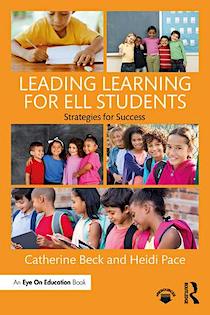A Leadership Tool to Improve EL Programs
Leading Learning for ELL Students: Strategies for Success
By Catherine Beck and Heidi Pace
(Routledge/Eye On Education, 2017 – Learn more)

Leading Learning for ELL Students is for all educational leaders at the district and school levels looking to evaluate and strengthen their current services for English Learners.
Though it is written with school and district administrators in mind, I would still highly recommend it for EL teachers as a guideline and vision for improving their ESOL programs.
The Contents of the Book
- Successful Strategies for Immigrant Students
- The Three-Legged Stool: Balancing the Roles of the School, the Students, and the Parents
- High-Impact Professional Development
- Culturally Proficient Pedagogy
- Leveling the Playing Field
- Preparing for Life after High School
- Diversity vs. Inclusion
What you will find
Each chapter begins with a quote related to the topic and ends with a district leader and school leader checklist to help guide the implementation of the ideas in the chapters. Many of the chapters include vignettes to help reiterate the importance of the work in the chapters. The chapters are full of strategies and ideas to strengthen programs for ELs.
Please refer to the following link to check out the online resource section to see a sampling of the goodies that you will find in the book: Leading Learning for ELL Students eResources. (Click on eResources.)
What was most valuable to me
One of the most impactful chapters for me was High-Impact Professional Development. With our rapidly growing population of ELs and our teacher shortage, this chapter alone made the book worth reading.
I am always looking for ways to better serve my ELs, and co-authors Catherine Beck and Heidi Pace gave me an entirely new vision for our program next year. Some of the suggestions from the chapter included:
- having teachers experience second-language learning themselves,
- using language coaches,
- co-teaching,
- book studies,
- using digital tools to provide self-paced professional development,
- peer observations,
- EdCamps, and
- podcasts.
From this chapter, I have decided to take on the role of co-teacher and language coach to help make a larger impact in my school for ELs.
My only criticism of the book is that the writing is a little dry. However, that could be viewed as a strength because it is clear, straightforward, and a quick read. It is laid out for easy navigation and immediate application.
In closing, I would recommend this book to all district and school leaders and ESOL teachers who want to improve services for ELs. Leading Learning for ELL Students has very useful tools and timely suggestions that can be implemented quickly and easily from day one!
Jordan Walker-Reyes (@MrsWalkerReyes1) is an English as a Second Language teacher with a master’s degree in literacy and a bachelor’s degree in early childhood and elementary education. Her experience includes teaching in multiple states in the southeastern United States in areas with high EL populations, including inner-city and rural communities. She is currently teaching ESL in middle school while pursuing an Ed.D. in curriculum and instruction.


































